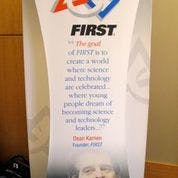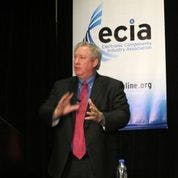A show of hands at a recent electronic components industry meeting confirmed what many executives are feeling as 2013 comes to a close: That the flat to only slightly up business conditions that have characterized the electronics supply chain for the last two years are going to stick around for a while. Only about one third of executives listening to an economics presentation at the recent Electronic Components Industry Association’s Executive Conference in Chicago raised their hands when asked if they thought their companies would finish 2013 with higher sales than 2012.
This is new to an industry in which growth tends to outpace the general economy, and it’s leaving many looking for new strategies that will help them better compete in a changing business climate. ECIA’s annual conference tackled the issue with the theme “Shift Happens,” and presented a slate of speakers from inside and outside the industry offering insight on how manufacturers and distributors of electronic components can navigate the change and still meet buyers’ and design engineers’ growing list of demands.
The ECIA audience of distributors, manufacturers and manufacturer representatives covers a big slice of the electronics marketplace, and presenters discussed everything from new market opportunities to honing your supply chain niche. Their advice provides a roadmap of where component suppliers will be looking for growth in the years ahead and offers a glimpse at areas the supply chain of the future will be focused on. Here are five of them:
1. Emerging technology
Component suppliers are always looking for “the next big thing” that will shake up the electronics industry, but such innovations have been elusive in today’s flat market. Still, there are some key product trends on the horizon companies should keep on their radar screens, says Jack Uldrich of The School of Unlearning, who spoke to ECIA attendees on the first day of the conference.
Wearable technology is one area. Many are predicting that this will be a huge market in the not-too-distant future, and Uldrich told attendees that it “absolutely could be,” pointing to the wearable computer Google Glass as a key example. The convergence of wearable technology and mobile health monitoring is also a big area, according to Uldrich. He pointed to a wide range of fitness and health-monitoring devices, such as the FitBit activity tracker, a wireless-enabled wearable device that measures a range of personal health metrics. Other key trends on Uldrich’s radar screen include 3D printing—he pointed to GE’s investment in the technology—and robotics, a particularly hot area for U.S. manufacturers.
2. The Internet of Things
The Internet of Things is all about connectedness—connecting people, processes and things to the web—and it’s a growing opportunity for companies of all kinds according to Uldrich and Intel’s Rick Dwyer, who also spoke on the first day of the ECIA conference.
To put it in perspective, Dwyer noted that as of late October there were 10.7 billion people, processes and things connected to the Internet—an impressive installed base of potential business that will only grow. The key to capitalizing on this potential is figuring out how to sell the service and solutions people need to enable their projects, programs and ideas, Dwyer said, urging attendees to ask: “What can we do differently to capture the value of the Internet of Things?” He pointed to opportunities in the Smartgrid as a prime example: utility companies are looking for new ways to manage and analyze energy use and spending, opening the door for companies who sell devices and technology that will allow them to do so in an online environment.
3. Honing your supply chain niche
Finding your place in a changing market is one of the most difficult parts of being in business—but it’s nothing new if you ask Steve Fisher, CEO of Philadelphia-based specialty distributor PEI-Genesis. In a presentation focused on business evolution and the importance of maintaining a “culture that cares and values that matter” Fisher recounted his family-owned firm’s evolutionary journey from a small start-up distributor of electronic parts to one of the world’s leading assemblers of precision connectors and power supplies.
Founded in 1946 by Fisher’s father, Murray Fisher, and his best friend Bernie Bernbaum, PEI-Genesis has been honing its niche as an international manufacturer, assembling distributor and engineering design firm for connectors and power supplies ever since. Today’s difficult economic times are presenting new challenges, but Fisher says PEI-Genesis is up to the task. After years of consistent growth, he said his company has failed to grow in the last 18 months. But Fisher advised that tough times are an opportunity to look in the mirror and ask yourself if you are still relevant—and then make the changes necessary to remain so.
“Shift happens,” he told attendees. “But don’t react mindlessly.”
Careful evaluation of business trends and internal capabilities has led PEI-Genesis to its place as a high-mix product business that builds more than 10 million connectors a year, Fisher explained. And though he didn’t say what was next for the firm, he emphasized that changing with the times while holding on to the values of its founding fathers would be a driving force in the company’s ongoing evolution. He suggested that all supply chain companies use a similar guiding light in today’s shifting economy.
4. Investing in the future
In one of the most inspiring presentations of the event—and the only one to receive a standing ovation—teenager Tim Balz talked about how the FIRST science and technology program changed his academic life and put him on the path to becoming an engineer and entrepreneur. His talk served as a wake-up call about the importance of investing in students to ensure a more successful electronics industry in the future.
Balz is a freshman at the Rose-Hulman Institute of Technology in Indiana, and he said he wouldn’t be there if it weren’t for FIRST—For Inspiration and Recognition of Science and Technology, a program that encourages elementary, middle and high school students to develop their science, engineering and technology skills through teamwork and competition. Schools throughout the country form FIRST teams that are sponsored by teachers, community volunteers and corporations. The teams are charged with building a robot that can perform a specific task in a series of competitions held across the country. Corporate sponsors play a large role supplying the electronic components, tools and other products students need to build their robots.
Balz emphasized the need for electronic component industry involvement in the program by telling his compelling story. A motocross rider with a 2.7 grade point average, Balz had little interest in academics until one of his teachers asked him to join his school’s FIRST program in his sophomore year. He quickly became a team leader and before he was out of high school had formed Freedom Chairs, a non-profit organization that recycles and rebuilds powered wheelchairs for anyone in need of mobility. The 18-year-old is president of Freedom Chairs, which is staffed by a team of student volunteers from Tim’s alma mater, Plainfield High School.
“[FIRST] turned my life around,” Balz told attendees. “It inspired me to try harder in school. I knew I couldn’t become an engineer with a 2.7 GPA.”
Balz finished high school with a 3.65 GPA.
5. Standing up to counterfeit electronics
Despite recent efforts to reduce the threat of counterfeit electronic components entering the market, the situation is not getting much better, according to Avnet’s Ed Smith, who made the subject a centerpiece of his presentation about industry market trends and issues. Smith, who is president of Avnet Electronics Marketing Americas, warned of a misunderstanding among customers about the meaning of authorized distribution and called for a new campaign to educate electronics buyers about the dangers of sourcing components from the open market.
Although counterfeit parts can find their way into authorized distributors’ inventory through customer returns, independent distributors and brokers represent the greatest threat because they do not purchase components directly from the original manufacturer. Many independents specialize in obsolete and hard-to-find parts and invest in testing and purchasing programs designed to detect counterfeits and keep them out of the supply chain, but only authorized distributors source components directly from original component manufacturers.
Smith pointed to efforts by authorized distributors to address the counterfeit problem, including supply chain management programs, design support, product obsolescence programs and aftermarket support designed to help customers avoid turning to the open market. He also said it’s time to hold customers accountable for their part in the problem. He urged the creation of a federal regulation that holds buyers responsible for purchasing counterfeit parts, saying they should be jailed. Smith used the harsh example to emphasize the danger of counterfeit parts entering the supply chain: a bad part can cause military equipment to fail on the battlefield, putting American soldiers’ lives in dangers. Others point to the danger of bogus parts in the commercial market as well. A faulty medical device or commercial jet places everyone in danger.
In addition to emphasizing the need for ongoing involvement by authorized distributors in the fight against counterfeit, Smith’s points represent another attempt to keep the issue front-and-center in an increasingly complicated economic landscape.











